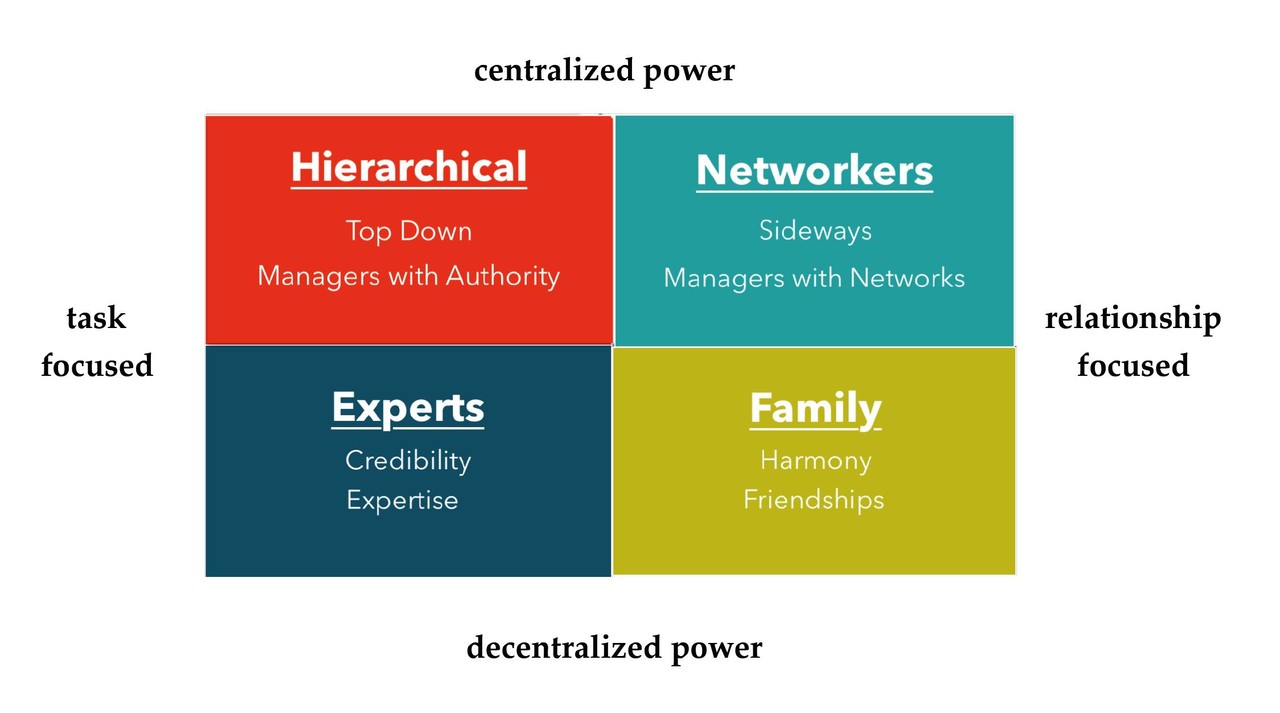
The Four Change Cultures
Over the last 18 months we analyzed 1,188 changes at 11 companies to find the most effective way to lead change. We learned a lot! One big insight was that many leaders don’t understand the type of culture they work in. This means that they lead in a way that goes against the grain and creates resistance. Have you ever met the manager who keeps telling everyone, “When I worked at G.E. we always ………….” The message should be clear. You don’t work at G.E. anymore! Our culture is very different and that is why your leadership style is bombing!
We found four different types of cultures in our research. Leaders need to know which they are working in as each favors a different change leadership approach. Which one do you work in?
1. Hierarchical cultures: Power and decision-making is concentrated at the top. Change is generally decided by powerful senior leaders and cascaded down. Staff value giving input but eventually want expect clear direction from managers about the direction and plans for the change. Leaders who do not provide clear guidance lose credibility and the likelihood of change success is seriously compromised.
Change key: the greatest predictor of change success in a hierarchical culture is: CLARITY of communication from senior leaders. Example: Many traditional corporations
2. Networker cultures: in these cultures things get done through relationships and who you know. The best change leaders are the senior managers who are: open and trusting, great collaborators and wide networkers. Command and control leaders are neither followed nor respected.
Change key: the greatest predictor of change success in a networker culture is COLLABORATION among senior stakeholders. Example: Many matrixed organizations and large family held businesses.
3. Expert cultures: in these organizations change is supported or blocked by the ‘smartest people in the room’. This might be the brilliant engineer who says ‘no’ or the rainmaker lawyer who says ‘yes’. Any change initiative that cannot be logically defended will be defeated (or ignored).
Change key: the greatest predictor of change success in an expert culture is: LOGIC and rigor of the case for change. Example: Many tech companies and law firms
4. Family cultures: in these cultures people have great autonomy over how much they will commit to a change. Change succeeds when people feel involved and part of a movement with people they like. Creating emotional bonds with people is critical. Managers who try to use power or focus only on the task isolate themselves and lead no one.
Change key: the greatest predictor of change success in a family culture is: CONSULTATION and community building before the change Example: Many non-profits and academic institutions, some tech companies
It is worth noting that no organization fits completely into one category. However, all companies have a dominant quadrant which can help leaders understand what will and will not work best when leading a change. When you lead a change in a way out of sync with your culture quadrant you will face greater resistance and need to expend much more: energy, time and money (and you’ll probably still fail).
Our Change Equation whitepaper is out in 2 weeks. If you want an advance copy email admin@nicholaspetrie.com and write ‘Preview Change Equation’ in the subject line.

Founder, Consultant, Coach & Speaker. Bringing out the best in others and making a positive impact, especially in times of change.
5yHmmm - looks very DiSC-esque. I’m curious to see the white paper.
An Independent Scholar of American Exceptionalism (Æ) 📚 Developing an interdisciplinary theory of Æ to address doubts and explain why US citizenship is worth it.
5yThis seems like a static and simplified version of the Competing Framework Model (Quinn & Rohrbaugh, 1983). Although the CFV is actually a continual measure, rendering it more accurate than this Fischer Price model (sorry for the crass).
Organisational Change Management | Consulting | Facilitation | Leadership Development
5yAny framework can be useful if it helps leaders to gain awareness and personal insight. This 'Four Change Cultures' model could also be applied to help reflect on the impact of national cultures on organisations and their corresponding leadership cultures. It reminds me a lot of Geerd Hofstede's famous study conducted at IBM Corporation which identified four archetypes of organizational culture. http://www.clarionlearning.com.au/leadership-development-news.php
Culture Solutions Director at Compass
5y4 types based on research at 11 companies. That seems a little light but maybe I am missing someone. Schein talks about not “typing” cultures and focusing on multi-dimensional analysis versus labeling of one type.
Enterprise Enabler - Business Strategist - Transformation Executive -
5yThanks for sharing 🙏